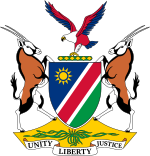Political system of Namibia
The Namibian Political System is organized as a semi-presidential system according to the Namibian Constitution of March 21, 1990 .
Since independence, SWAPO has had sole power of governance due to its dominance in the election results, which means that Namibia's political system tends to resemble a one-party system . Nevertheless, Namibia has a functioning democracy . Non-governmental organizations such as the Namibian Institute for Democracy , the National Society for Human Rights (NAMRIGHTS) or the Legal Assistance Center promote democratic education and an understanding of a multiparty system .
executive

The executive branch consists of the Namibian President , Vice-President , Prime Minister and Vice Prime Minister and the ministers.
The president is directly elected by the people for five years and appoints the prime minister , vice prime minister , vice-presidents and the ministers or can also dismiss them independently. He also has the right to dissolve the National Assembly.
When the President declares a state of emergency , the approval of a two-thirds majority of the National Assembly is required.
legislative branch

The legislature ( legislation ) is a two-chamber system and is formed by the National Assembly and the National Council.
The National Assembly ( English National Assembly ) is composed of 104 deputies (until March 19, 2015 78 deputies) together. Of these, eight (until March 19, 2015 six) members are appointed directly by the president, the other members are elected directly by the people via party lists according to proportional representation. The National Assembly has the legislative power and can repeal or correct any act of the President by a two-thirds majority of the MPs.
In addition, the members of the National Assembly have the option of a vote of no confidence . In this context, the President must revoke the appointment of a cabinet member if the National Assembly decides by a majority of its members that the minister concerned does not have their confidence. Another special right of the National Assembly, in addition to participation in the declaration of a state of emergency, is the impeachment procedure . This can be initiated due to a breach of the constitution or serious violation of the law and requires a two-thirds majority of the members of the National Assembly and a two-thirds majority in the National Council.
The National Council ( English National Council ) includes three each (until 2014 two) members of the 14 regions (to 2013 13 regions), irrespective of the population size of each region. The representatives in the National Council are elected by the respective regional council from among the members of the regional council elected by the people .
Due to the strong position of the president and the prevailing majority in favor of SWAPO, the two chambers of parliament play a rather subordinate role in the political decision-making process. According to the constitution, all members of the government must also be members of the National Assembly, and vice ministers must belong to one of the two chambers. With currently more than 50 ministers and vice ministers out of a total of 104 members of the National Assembly, this in turn means that the parliamentary work sometimes has to be carried out by a minority of members (in 2015 by only about half of the 104 members). In the past, the National Assembly was often unable to meet due to a lack of a quorum . In the future, however, it should be possible to achieve this more quickly by changing the constitution in 2014.
Judiciary

The judiciary (jurisprudence) is made according to the constitution of three judicial bodies together, the Supreme Court , the High Court and Lower Courts . The Supreme Court has been the highest court of appeal in Namibia since 1990. The jurisdiction for criminal offenses comes with certain restrictions regarding the severity of the offense, the possible penalty and the territorial area of competence, the Magistrates Courts , as part of the Lower Courts.
The Roman-Dutch Law (Roman-Dutch law) as well as judgments of the South African and Namibian jurisprudence serve as the basis of the jurisdiction according to the Common Law and the Customary Law.
The judiciary in Namibia is considered independent of the influence of the government, but its independence is sometimes called into question by appeals from various organizations (especially trade unions ).
See also
literature
- Anton Bösl: Namibia. Data and facts . Konrad-Adenauer-Stiftung eV, Windhoek 2009.
- N. Horn, A. Bösl (Ed.): Human rights and the rule of law in Namibia . Macmillan Namibia, Windhoek 2008, ISBN 978-99916-0-915-7 .
- N. Horn, A. Bösl (Ed.): The independence of the judiciary in Namibia . Macmillan Namibia, Windhoek 2008, ISBN 978-99916-0-807-5 .
- Frank L. Watz: The fundamental rights in the Constitution of the Republic of Namibia of March 21, 1990 . Klaus-Hess-Verlag, 2004.
- Wilfried Röhrich: The political systems of the world . Verlag CH Beck, Munich 1999, ISBN 3-406-44728-7 .
Web links
- Official site of the Government of Namibia (English)
- Page of the Parliament of Namibia (English)
- Site of the Supreme Courts of Namibia
Individual evidence
- ↑ Official website of the Legal Assistance Center (English)
- ↑ Parties and party systems in Namibia. (PDF; 218 kB) In: Friedrich Ebert Foundation . Retrieved April 21, 2010 .
- ↑ kas.de
- ↑ NUNW calls for the reform of the judiciary. In: Allgemeine Zeitung. December 24, 2009.

